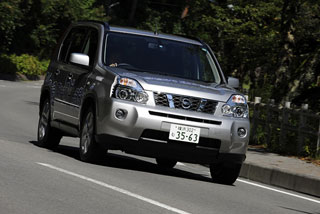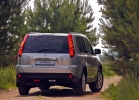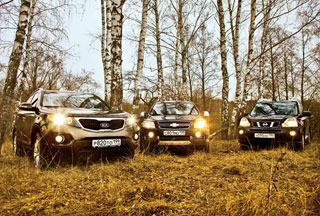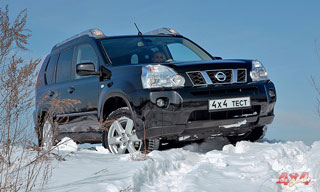Nissan X-Trail test drive since 2007 SUV
Review of the Nissan X-Trail 20GT crossover with a new generation diesel engine
 If a car with a diesel engine, it must necessarily be clean, this is what a requirement is now presented to all manufacturers who intend to use these power plants in their machines. It seems difficult for some to some, and they refuse, but Nissan does not. Moreover, without waiting, while the new environmental safety rules become mandatory for everyone, the company produces the first clean diesel car of domestic production of the X-Trail 20GT to the Japanese market. So, the acquaintance took place, and it is time to share the first impressions. We asked our journalist about this, who had already tested the new diesel, and this is what he told us.
If a car with a diesel engine, it must necessarily be clean, this is what a requirement is now presented to all manufacturers who intend to use these power plants in their machines. It seems difficult for some to some, and they refuse, but Nissan does not. Moreover, without waiting, while the new environmental safety rules become mandatory for everyone, the company produces the first clean diesel car of domestic production of the X-Trail 20GT to the Japanese market. So, the acquaintance took place, and it is time to share the first impressions. We asked our journalist about this, who had already tested the new diesel, and this is what he told us. Acts soothingly
The overall impression of traveling on the new Nissan X-Trail briefly is as follows: the car turned out to be almost the way I imagined it. After all, cars with diesels of a new wave are only for us, the Japanese, in a new product, and in Europe, half of the park has been transferred to such motors. And there is no reason to doubt that their number will grow further, and more and more Europeans will give preference to diesel traction.
So it is not at all surprising that among the mass of Nissan X-Trail cars of the current generation that go to the West, there are also those that are equipped with diesel engines. And in Europe, such cars are successful. Knowing this, I was not at all surprised when I found out that the X-Trail entered the sale with a new diesel engine. After the previous smoky diesel machines began to be considered an old man's relic, it seemed to many that, in principle, Japan could do without them. What a beautiful misconception! After all, it is only worth calculating what the operation of a car on a gasoline motor can become, and then make a similar calculation with applied to a diesel engine, it will immediately become clear that it is profitable and what is not. So personally, I was always sure that the only thing is to create a new, clean diesel suitable for installation on SUV (Sport Utility Vehicle) or minivan. And as soon as he appears, the positive reaction of customers will not be long in coming.
 These are the thoughts swarmed in my head while I was sitting behind the wheel of the diesel X-Trail 20GT, about to move on the road-road. After the car moved, I first drew attention to a powerful torque, which demonstrated by and large a small engine (only 2 lira!) Already at low speeds. In fact, 36.7 kg-m at a rotation frequency of 2,000 rpm. This, I will report to you, something! For comparison: in order for the gasoline engine to give out the same thing, it is necessary that the working volume of its cylinders be approximately 3.5 liters. So not that, it seemed to me that in the range from 1,500 rpm. and up to 3,000 rpm. The torque is practically unchanged. And what does this, in particular, mean? Yes, only that the car can slow down can again accelerate in the same gear. And for sure: even when the transmission worked at high speed, and I had to drop a little move, the need for a subsequent transition to a low gear, as a rule, it was not worth it to press the accelerator again, and I was again pressed into the back of the seat, and went away and went .
These are the thoughts swarmed in my head while I was sitting behind the wheel of the diesel X-Trail 20GT, about to move on the road-road. After the car moved, I first drew attention to a powerful torque, which demonstrated by and large a small engine (only 2 lira!) Already at low speeds. In fact, 36.7 kg-m at a rotation frequency of 2,000 rpm. This, I will report to you, something! For comparison: in order for the gasoline engine to give out the same thing, it is necessary that the working volume of its cylinders be approximately 3.5 liters. So not that, it seemed to me that in the range from 1,500 rpm. and up to 3,000 rpm. The torque is practically unchanged. And what does this, in particular, mean? Yes, only that the car can slow down can again accelerate in the same gear. And for sure: even when the transmission worked at high speed, and I had to drop a little move, the need for a subsequent transition to a low gear, as a rule, it was not worth it to press the accelerator again, and I was again pressed into the back of the seat, and went away and went . So all the time, while I rolled out on public suburban roads, the transmission acted on the 6th, well, sometimes in 5th gear, but not lower than that. At the entrance to the city, however, I had to expand the range of speeds used and connect from time to time and the 4th gear, but the city is the city. But what is interesting: realizing that my car constantly has a decent power reserve, I got used to it very quickly, and began to behave (and the car too) is much calmer and more balanced. This is understandable: you no longer have to constantly hold on to the speed lever, you only work with a pedal, and the machine still stretches. Isn't it a reason to stop twitching and spinning? Here you have a means to wean too nervous drivers from inadequate behavior on the road!
A catalyst that the impossible makes it possible
 However, such an engine is good not only in that allows the driver to relax and calm down, but also leads to a significant reduction in fuel costs. Among all other thermal engines, the highest K.P.D. (that is, the ratio of the cost of fuel and the generated energy) still remains with the motor working on the solarium, this is a fact. Here, for example, the control data of the Nissan X-Trail car: when following in a mixed cycle on one liter of fuel, it is possible to overcome 15.2 km (6.6 liters per 100 km). In practice, this means that the average consumption will be approximately 1 liter per 10 km of run. Given that the tank holds 65 liters of fuel, it can be argued that the car at one gas station is capable of overcoming about 700 km. In order for this stringence to become even more noticeable, maybe even it would be worth it to reconfigure the motor so that the zone of its critical revolutions does not begin at 4,500 rpm., But a little earlier, for example, from 3,500.
However, such an engine is good not only in that allows the driver to relax and calm down, but also leads to a significant reduction in fuel costs. Among all other thermal engines, the highest K.P.D. (that is, the ratio of the cost of fuel and the generated energy) still remains with the motor working on the solarium, this is a fact. Here, for example, the control data of the Nissan X-Trail car: when following in a mixed cycle on one liter of fuel, it is possible to overcome 15.2 km (6.6 liters per 100 km). In practice, this means that the average consumption will be approximately 1 liter per 10 km of run. Given that the tank holds 65 liters of fuel, it can be argued that the car at one gas station is capable of overcoming about 700 km. In order for this stringence to become even more noticeable, maybe even it would be worth it to reconfigure the motor so that the zone of its critical revolutions does not begin at 4,500 rpm., But a little earlier, for example, from 3,500. Yes, but in order to have a more or less complete idea of \u200b\u200bthe machine, it is not enough to know what its motor is. In other words, if I suddenly liked the car, this is not only because it has some kind of special engine (although this is also important), but because, figuratively expressing myself, everything is fine in it. In fact, the car runs along the rolled road, and behaves like a comfortable passenger car. Here, the creators of the X-Trail should be said to be respect! But it should be borne in mind that a 90 kg diesel engine is heavier than gasoline, and, accordingly, this increases the weight of the front of the machine. By the way, it is precisely because of this that it often happens that if in the same model range there is both a gasoline and diesel model, then the controllability of these machines differs significantly. It’s good, however, that this time such variability was avoided. That is, whether you are sitting at the wheel of the X-Trail, which works on gasoline, or on its diesel fellow, in terms of controllability, no difference. Of course, if you tune in a negativity in advance, you can notice that when you get out of the turn, the diesel leads to the side a little stronger, but this is a pure subjectiveism, nothing more. When the body was prepared in production, the designers tried to patch all the smallest holes that lead from the cabin into the engineering space, and generally outside. That's probably why, if you listen to the sounds coming from the engine, then a firm feeling is created that in its path the sound wave has to overcome 2-3 sound-absorbing layers, no less. And as a result, this sound merges with a noise from the friction of the tires on asphalt, and ceases annoyingly, as is often in diesel salons, climb into the ears and act on nerves.
 Well, well, noise is not the most important problem. The main thing is how to achieve the compliance of the diesel engine with environmental requirements, which are now more stringe and stricter. Moreover, in two years, new, more stringent standards for diesel engines will be introduced. And here the moment of truth comes, since the X-Trail 20GT I described is the first Japanese car that meets these standards. As for the solid particles contained in the combustion products of diesel fuel, it is more or less clear. But how to neutralize nitrogen oxides that are formed as a result of this combustion, this is, indeed, a task. At first, it was not even clear how this is possible. And here it turned out! Moreover, the engineers did not need to hang a bulky device for injecting a water solution of aqueous solution of carbamide or even worse for this. No, the exhaust gas was forced to independently release molecules, which, entering into a chemical reaction with oxides, give restored nitrogen, water and carbon dioxide at the output. Here is such a focus!
Well, well, noise is not the most important problem. The main thing is how to achieve the compliance of the diesel engine with environmental requirements, which are now more stringe and stricter. Moreover, in two years, new, more stringent standards for diesel engines will be introduced. And here the moment of truth comes, since the X-Trail 20GT I described is the first Japanese car that meets these standards. As for the solid particles contained in the combustion products of diesel fuel, it is more or less clear. But how to neutralize nitrogen oxides that are formed as a result of this combustion, this is, indeed, a task. At first, it was not even clear how this is possible. And here it turned out! Moreover, the engineers did not need to hang a bulky device for injecting a water solution of aqueous solution of carbamide or even worse for this. No, the exhaust gas was forced to independently release molecules, which, entering into a chemical reaction with oxides, give restored nitrogen, water and carbon dioxide at the output. Here is such a focus! After such tricks, all competing companies that have intended to restore the production of diesel cars are simply obliged to take as a basis the high bar that Nissan engineers set them to go even further (and how else?). So the value of the new X-Trail 20GT is simply difficult to overestimate. This miracle engine of the M9R model is the joint development of Nissan and Renault, and it is gathering in France. The Japanese side brought into it the advanced technology of cleaning the exhaust gases, which was perceived by Europeans very with interest, since they themselves will have to face such tough restrictions (Euro-5), and here you will please! Already a finished recipe for how to live on.
In the future, it is desirable that there is an automatic transmission
 Despite the general enthusiastic mood, I would not be if I had not tried to find something that would cause complaints, this is as usual. Well, what about it, you need to speculate in advance how a simple Japanese driver will react to one side or another, so I try. Here, for example, I come to the conclusion that in terms of noise that penetrates the salon, the new X-Trail and is not close to the old diesel machines of this class, this is true. But at the same time, it should be noted that I do not experience any special delights about this, because at idle the car still rummages with low bass, but I would like the engine to whisper, as the gasoline counterpart does it. In Europe, I am sure that no one will pay attention to this circumstance, but they know in this regard the Japanese in this regard, which are selective and demanding. And before paying money for something, they definitely need to know exactly what. It is possible that this is congenital impudence, but you won’t get anywhere, right?
Despite the general enthusiastic mood, I would not be if I had not tried to find something that would cause complaints, this is as usual. Well, what about it, you need to speculate in advance how a simple Japanese driver will react to one side or another, so I try. Here, for example, I come to the conclusion that in terms of noise that penetrates the salon, the new X-Trail and is not close to the old diesel machines of this class, this is true. But at the same time, it should be noted that I do not experience any special delights about this, because at idle the car still rummages with low bass, but I would like the engine to whisper, as the gasoline counterpart does it. In Europe, I am sure that no one will pay attention to this circumstance, but they know in this regard the Japanese in this regard, which are selective and demanding. And before paying money for something, they definitely need to know exactly what. It is possible that this is congenital impudence, but you won’t get anywhere, right? Well, here, looking for what to find fault with this, so that everyone would finally feel good, I decided that the transmission (6-speed manual) is not the best option for such a machine. The developers in this regard should not be seduced by the fact that, they say, the buyer accepted the car with a bang, and today the number of applications (about 1,000, by the way) more than expected. I am sure: in order to sharply expand the circle of people who want to purchase a new X-Trail 20GT, you need to offer them not only mechanics, but also an automatic transmission. Well, yes, I understand the difficulties with which the creators may encounter along this path. Well, how, a stepless variator, designed for a powerful torque, like the one that is put on Murano, of course, here.
 it was also useful, but only under the hood of the X-Trail there was not enough free space for him. And if the variator is more compact and, accordingly, weaker, it may not withstand the steel belt. Yes, all this is so, but you can put a simple automatic machine, or am I wrong?
it was also useful, but only under the hood of the X-Trail there was not enough free space for him. And if the variator is more compact and, accordingly, weaker, it may not withstand the steel belt. Yes, all this is so, but you can put a simple automatic machine, or am I wrong? Of course, taking into account the tightening requirements for ecology, each manufacturer is trying to get ahead of their competitors so that buyers take only his cars. That is why, as I understand it, the creators of the X-Trail 20GT put a mechanical transmission on their car, so that, as they say, to get into the battle, and there, they say, we will see. By the way, the abbreviation GT in the name of the car just says that this car is itself. So here everything seems to be honest. Indeed, it is also intended for the X-Trail for off-road driving, so this can partly justify the choice in favor of a mechanical rather than automatic transmission, this is so. But for sure, after the X-Trail, its more comfortable Nissan Dualis double (analogue of Nissan Qashqai) will be transferred to diesel traction, right? But in it, after all, a machine gun cannot be dispensed with by definition. So the faster the engineers select an automatic transmission under diesel, the better.
 However, the whole thing of the future, and now I am entirely welcome to the appearance of the first diesel car of the new wave on the Japanese land, and with interest I will follow how its further commercial fate will take shape.
However, the whole thing of the future, and now I am entirely welcome to the appearance of the first diesel car of the new wave on the Japanese land, and with interest I will follow how its further commercial fate will take shape. Technical characteristics of the car Nissan X-Trail 20GT
Full length: 4 630 mm.
Full width: 1 785 mm.
Complete height: 1 685 mm.
Wheel base: 2 630 mm.
Machine weight: 1 660 kg.
Drive: complete.
Engine: a 2.0-liter diesel with turbocharged, a 4-cylinder with a vertical-row location of the cylinders, the DOHC gas distribution mechanism with 16 valves, the developed power of 173 hp. (3 750 rpm), the greatest torque 36.7 kg-m (2,000 rpm)
Basic price: 2 999 850 yen ($ 30 880).
The price of the tested machine: 3 442 350 yen ($ 35,435).
The difference in price arose due to the following optional equipment and materials:
Bi-xenon headlights (63 thousand yen);
Car Wings navigation system (346.5 thousand yen);
Electronic system for charging for the trip (33 thousand yen).
A source: Webcg.net
NISSAN X-TRIIL Video Video since 2007
Nissan X-Trail Crash Video since 2007
Nissan X-Trail test drives since 2007
Nissan X-Trail Crash Test since 2007
Krassh Test: Detailed Information30%
Driver and passengers
12%
Pedestrians
43%
Children-passengers
















